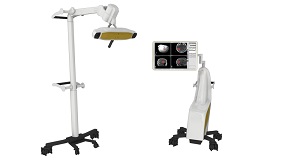
What is Computer-Assisted Spine Surgery?
Computer-assisted spine surgery is an instrument tracking technology in which the surgical instruments are viewed with the help of three-dimensional images of the spine. This technology increases the accuracy and safety of the spinal procedures which cannot be achieved with traditional spinal surgical approaches.
Computer-assisted spine surgery consists of specialized software that creates a virtual, three-dimensional map of the spine and guides the surgeon through the procedure. Your surgeon tracks the real-time position of surgical instruments and is able to operate with improved accuracy. This technology is similar to GPS tracking of automobiles on the road by a GPS satellite.
Computer-assisted spine surgery involves
- Digital camera array to track instruments with references to the spine
- Computer with specialized navigation software
- Monitors to view the operation site in real-time
- Smart instrumentation including wireless devices such as:
- Pedicle feeler for probing
- Awl for making or enlarging holes in the bone
- Spine tracker attached to a vertebra to maintain the accuracy of 3D imagery even when the patient is repositioned
Indications for Computer-Assisted Spine Surgery
Computer-assisted spine surgery is used for carrying out various spinal surgeries such as discectomy, laminotomy, and foraminotomy, which include the removal of the damaged parts of the vertebral bone.
Computer-assisted spine surgery helps in placing implants such as pedicle screws to treat spinal instability during a spinal fusion procedure. Conditions that cause spinal instability include:
- Spinal stenosis
- Spinal deformity
- Spondylolisthesis
- Fractures
- Degenerative disc disease
- Tumors or infections
Pre-procedural Preparation for Computer-Assisted Spine Surgery
Before the surgery, your surgeon will order computer tomography (CT) or Magnetic resonance imaging (MRI) scans of the diseased spine and feed the images into the navigation computer. The specialized software then creates a three-dimensional, virtual image of the spine. Using these images, your surgeon can plan details of the surgery such as the size of instrumentation to use and for determining the point of entry. Your surgeon marks reference points on the images to guide the procedure. A camera is fixed to the vertebra to track the position of the spine and instruments.
How is Computer-Assisted Spine Surgery Performed?
Computer-assisted spine surgery is performed under general anesthesia. Your surgeon makes an incision over the site to be operated, either on the back or the neck. A spine tracker with a camera is clamped to the vertebra to project real-time images onto the computer screen.
The procedure starts with a registration process, in which your surgeon matches the predefined points on the computer by touching the patient’s true spine with the smart instrumentation.
Once the registration is completed, your surgeon uses smart specialized instruments and performs spine surgery. During the surgery, your surgeon can view both the exposed spine as well as the computer-generated image on the monitor. The computer also displays different angles of the surgical site and the path that an instrument can take when inserted, which can help accurately position the instruments.
When pedicle screws need to be inserted to stabilize the repaired bone, the software measures accurate points of insertion of the pedicle screws and monitors the instrumentation as the holes for the screws are being drilled into the bone, ensuring the right depth is attained. The smart instrumentation is removed and the metal rods are placed to stabilize the spine.
The incision is closed and the procedure is completed.
Post-Operative Care following Computer-Assisted Spine Surgery
After the surgery, your doctor will counsel you regarding post-operative care to help you recover faster. Avoid lifting, bending, running, or engaging in high-impact activities for a few weeks. You may have to wear a brace after the surgery. Your doctor will suggest post-operative rehabilitation or an exercise program for stretching and strengthening your spine.
Risks and Complications of Computer-Assisted Spine Surgery
As with any surgery, computer-assisted spine surgery involves certain risks and complications. They include:
- Infection
- Destabilization of the implants
- Spinal cord injury
- Persistent pain
Benefits of Computer-Assisted Spine Surgery
Advantages of computer-assisted spine surgery include:
- Easy navigation to the problem area
- Soft tissues can be pushed aside instead of cut
- Enables preplanned surgery
- Multiple procedures can be performed in a single session
- Accurate measurements and targeting of instrument placement
- Ability to view the path that an instrument would take
- Faster recovery than traditional surgery
- Enhanced visualization
- Eliminates the need for repeat X-rays
- Improved efficiency and safety
- Reduced operating time
Computer-assisted spine surgery is a safe and efficient procedure that has gained popularity in recent years with advances in computer technology. This minimally invasive technique allows accurate and active tracking of the surgical instruments during the procedure. Talk to Dr. Saifi if you wish to learn more about computer-assisted spine surgery in Houston, Baytown, TX.





